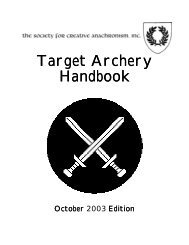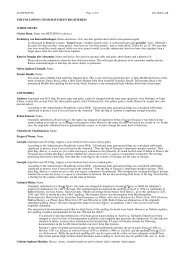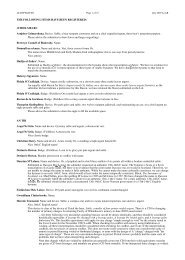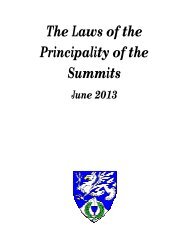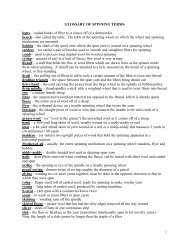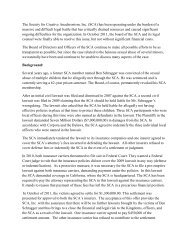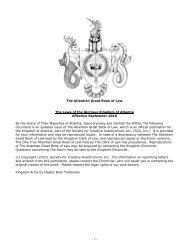The Standards for Evaluation of Names and Armory - SCA Heraldry
The Standards for Evaluation of Names and Armory - SCA Heraldry
The Standards for Evaluation of Names and Armory - SCA Heraldry
Create successful ePaper yourself
Turn your PDF publications into a flip-book with our unique Google optimized e-Paper software.
<strong>The</strong> <strong>St<strong>and</strong>ards</strong> <strong>for</strong> <strong>Evaluation</strong> <strong>of</strong> <strong>Names</strong> <strong>and</strong> <strong>Armory</strong>:<strong>The</strong> Rules <strong>for</strong> SubmissionsFor example, the name phrase de London is typical <strong>of</strong> medieval English documentary practice. <strong>The</strong>re<strong>for</strong>e, itis a registerable name phrase. However, von Saxony, which mixes the German von with the English version<strong>of</strong> the German place name, is not. It must be made completely German, as von Sachsen, or completelyEnglish, as <strong>of</strong> Saxony. For example, inghean Áeda, which mixes the Early Modern Irish Gaelic inghean,with the Middle Irish Gaelic Áeda , is not registerable. It must be made completely Middle Irish Gaelic, asingean Áeda, or completely Early Modern Irish Gaelic, as inghean Aodha.2. Sources <strong>of</strong> Name Phrases: We allow registerable name phrases to be created in a variety <strong>of</strong> ways. <strong>The</strong>following types <strong>of</strong> name phrases may be registered:a. Attested Name Phrases: Name phrases may be attested to period as a complete name phrase (i.e., foundin a period document). A single example <strong>of</strong> an attested name phrase clearly dated to period is sufficientto demonstrate its use. Minor spelling variants are allowed when those spelling variants are demonstratedto be compatible with the spelling conventions <strong>of</strong> the time <strong>and</strong> place <strong>of</strong> the attested name.For example, in Renaissance English, the letters i <strong>and</strong> y are frequently interchanged. <strong>The</strong>re<strong>for</strong>e, a nameattested as Annis could also be spelled Annys. <strong>The</strong> letters k <strong>and</strong> q, on the other h<strong>and</strong>, are notinterchangeable in Renaissance Scots. So, a name attested as Kintyre does not justify the spellingQintyre.b. Constructed Name Phrases: Name phrases may be constructed from attested period name elements. Todo this, documentation must be provided to demonstrate that the name phrase follows a period pattern.We generally require at least three examples to consider something a pattern, as sometimes a single namephrase can create the appearance <strong>of</strong> a pattern that does not actually exist. <strong>The</strong> examples should closelymatch the constructed name phrase.For example, taken alone, the English given name Rose appears to originate from the name <strong>of</strong> the flower;however, research suggests that it originates from an Old English word hros, 'horse'. <strong>The</strong>re<strong>for</strong>e, it cannotbe used to justify names like Hyacinth.All <strong>of</strong> the elements <strong>and</strong> patterns <strong>for</strong> a constructed name phrase must come from a single time <strong>and</strong> place.We do not allow constructed name phrases that are created by using patterns from one time <strong>and</strong> placewith elements from another time <strong>and</strong> place. Some examples <strong>of</strong> constructed names are:1. Diminutives Constructed from Given <strong>Names</strong>: In many languages, diminutive <strong>for</strong>ms can be madefrom existing given names, <strong>of</strong>ten by adding endings or removing part <strong>of</strong> the name (<strong>and</strong> even both).For example, in Italian, diminutives are regularly constructed by adding –ino after dropping the final –<strong>of</strong>rom an already existing given name. <strong>The</strong> diminutive Urbanino can be constructed from the attestedgiven name Urbano.2. Constructed Dithemic Given <strong>Names</strong>: In several Germanic languages, including Old English, givennames are frequently composed <strong>of</strong> two pieces, a prototheme (first part) <strong>and</strong> a deuterotheme (secondpart). New names can be constructed from attested protothemes <strong>and</strong> deuterothemes. A new namecannot be constructed by combining other parts <strong>of</strong> the names or by combining elements other than asingle prototheme <strong>and</strong> a single deuterotheme.For example, the attested Old English name Ælfgar has the prototheme Ælf- <strong>and</strong> the deuterotheme -gar<strong>and</strong> the attested Old English name Eadmund has the prototheme Ead- <strong>and</strong> the deuterotheme -mund.<strong>The</strong>re<strong>for</strong>e one could combine the prototheme Ælf- <strong>and</strong> the deuterotheme -mund to make the givenname Ælfmund. However, Garmund or Ælfead are not documentable through this pattern, nor isÆlfgarmund, as these do not combine a single prototheme with a single deuterotheme.<strong>St<strong>and</strong>ards</strong> <strong>for</strong> <strong>Evaluation</strong> <strong>of</strong> <strong>Names</strong> <strong>and</strong> <strong>Armory</strong> – April 29, 2012 - Page 8 <strong>of</strong> 73



